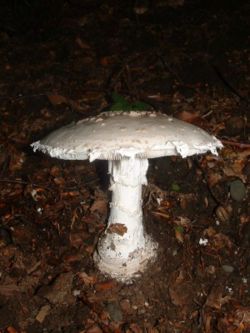| Amanita strobiliformis | |
|---|---|
 | |
| Scientific classification | |
| Kingdom: | Fungi |
| Division: | Basidiomycota |
| Class: | Agaricomycetes |
| Order: | Agaricales |
| Family: | Amanitaceae |
| Genus: | Amanita |
| Species: | A. strobiliformis |
| Binomial name | |
| Amanita strobiliformis (Paulet ex Vittad.) Bertill. | |
| Amanita strobiliformis | |
|---|---|
| Mycological characteristics | |
| Gills on hymenium | |
| Cap is flat | |
| Hymenium is free | |
| Spore print is white | |
| Ecology is mycorrhizal | |
| Edibility is not recommended | |
Amanita strobiliformis is a species of mushroom. It is commonly referred to as warted amanita. [1]


